Bennemann K.H., Ketterson J.B. Superconductivity: Volume 1: Conventional and Unconventional Superconductors; Volume 2: Novel Superconductors
Подождите немного. Документ загружается.


1090 P.S. Riseborough,G.M. Schmiedeshoff,and J.L.Smith
rate.Theobservationofananomalouspeakinthe
phonon density of states [273] provides supporting
evidence for the validity of the breathing mode pic-
ture of UPt
3
. The attenuation of longitudinal sound
waves in CeCu
6
[274] is somewhat similar to that of
UPt
3
inthatitshowsa peak belowatemperatureof 10
K. However, unlike UPt
3
, the intensity of the peak in
CeCu
6
scales linearly with frequency. Furthermore,
the peak broadens and shifts to higher temperatures
with increasing phonon frequency.
19.3.3 Dynamic Magnetic P roperties
Just as the effects of the collective magnetic fluctua-
tions and the low temperature gas of heavy quasi-
particles show up in the transport and thermo-
dynamic properties of heavy-fermion materials, the
effects of these excitations also show up in the mag-
netic properties.
Nuclear Magnetic Relaxation
In the presence of an applied static magnetic field,
a nuclear spin relaxes to its ground state through
interaction with the fluctuations of the electronic
magnetic moments. On assuming that the coupling
is weak so that the Born approximation is valid, the
longitudinal relaxation rate 1/T
1
can be expressed
in terms of the hyperfine field coupling A
hf
(r − r
)
between the nuclear spin point r
to the magneti-
zation density M
(r) and the dynamic susceptibility
+,−
(q; !)via
T
1
= k
B
T
1
N
q
A
hf
(q)
2
Im
+,−
(q; !
N
)
!
N
.
(19.158)
In this, A
hf
(q) is the spatial Fourier transform of
the hyperfine field, and !
N
is the nuclear Larmor
frequency which, in conventional metals, can be ne-
glected as it is much smaller than the lowest energy
scale for the electrons. The dynamic magnetic sus-
ceptibility is the spatial and temporal Fourier trans-
form of the quantity
˛,ˇ
(r; t) defined by the causal
correlation functioninvolvingthe commutator ofthe
components of the magnetization density
˛,ˇ
(r; t)=−
i
< |
M
˛
(r; t), M
ˇ
(0; 0)
| > Ÿ(t) ,
(19.159)
where Ÿ(t) is the Heaviside step function. In the
paramagnetic state, the susceptibility tensor is spin
rotationally invariant so one has
x,x
(r; t)=
y,y
(r; t)=
z,z
(r; t)=
1
2
+,−
(r; t) .
(19.160)
Due to the Shibarelation [275],oneexpects that,for a
local paramagnetic Fermi liquidin the limit ! → 0,
the imaginarypartof thesusceptibility shouldsatisfy
the equation
lim
!→0
(2J +1)
J(J +1)
3
Im
z,z
(0; !)
!
=
z,z
(0; 0)
g
B
2
.
(19.161)
This suggests that, with a q
independent hyperfine
coupling, the longitudinal nuclear relaxation rate of
heavy-fermion systems should vary as the square
of the low temperature static susceptibility or the
square of the coefficient in the specific heat, much
the same as the correlation between the coefficient
of the T
2
term of the resistivity and the linear T
term in the specific heat found by Kadowaki and
Woods [237]. For materials such as UBe
13
[276], the
scaling with the square of the quasi-particle den-
sity of states is not followed due to the q
depen-
dence of the coupling and vertex corrections. Never-
theless, magnetic relaxation experiments on heavy-
fermion compounds at low temperatures do show the
linear T Korringa relaxation rate with an enhanced
magnitude, indicating the existence of heavy quasi-
particles.
The Knight shift K is a shift in the nuclear reso-
nance field which provides a measure of the induced
field at the site of the nucleus due to the polariza-
tion of the electronic system. It is often found that
the induced field is dominated by the bulk static sus-
ceptibility
z,z
(0; 0) of the f electrons and so can be
used as an estimate of the strength of the average
hyperfine field
K =
A
hf
g
N
N
z,z
(0; 0) . (19.162)
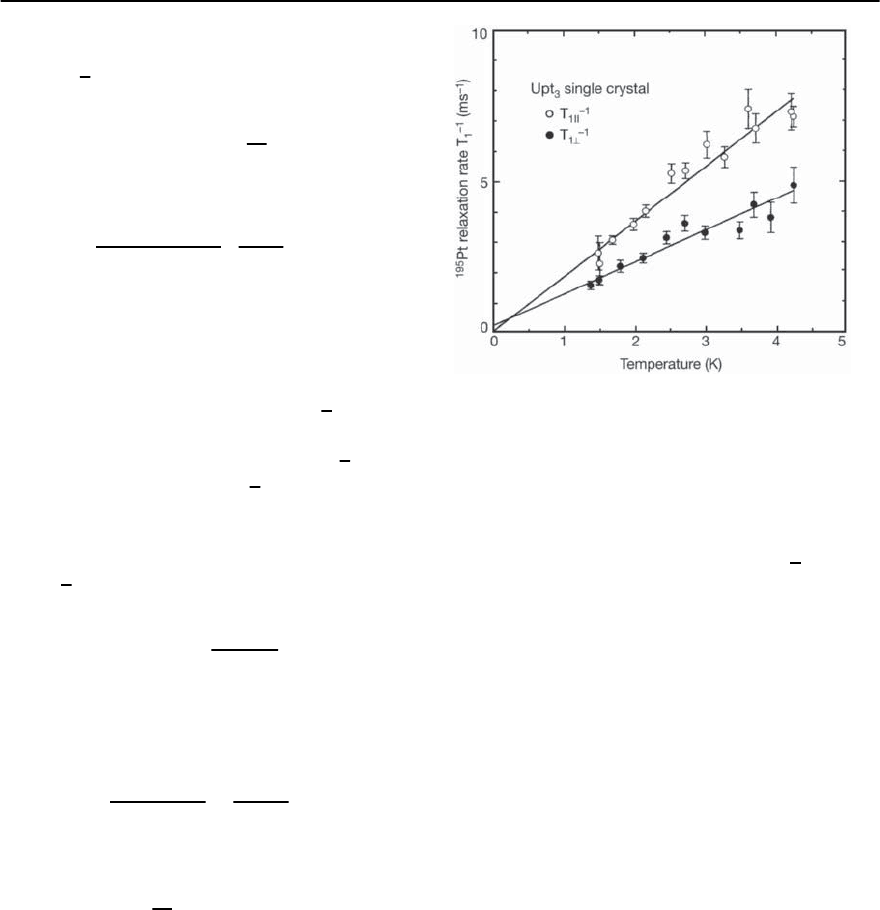
19 Heavy-Fermion Superconductivity 1091
Assuming a local isotropic hyperfine field and
isotropic q
independent magnetic fluctuations, one
finds the dimensionless Korringa product
S = k
B
TK
2
T
1
(19.163)
has the theoretical value
S
0
=
(2J +1)J(J +1)
6
g
e
B
g
N
N
2
(19.164)
for ions with magnetic moment J.Correctionsmust
be made to this relation for heavy-fermions com-
pounds with anisotropic susceptibilities.Themagni-
tude of the Korringa ratio is defined as SS
0
.Since the
relaxation rate involves a sum over all q
,deviations
from the ideal value of the Korringa ratio may be
used to inferthe relative magnitude of the q
averaged
susceptibility to the uniform ( q
= 0) susceptibility.
The Knight shift and the longitudinal relaxation
rate can be used to estimate the typical frequency of
local moment fluctuations.Assuminga phenomeno-
logical q
independent relaxational form for the dy-
namic susceptibility
z,z
(!)=
z,z
(0)
− i!
, (19.165)
where is the relaxation rate, one finds that, if
!
N
, the transverse relaxation rate can be ex-
pressed in terms of the limit
lim
!
N
→0
Im
z,z
(!
N
)
!
N
=
z,z
(0)
. (19.166)
Thus, the spin-fluctuationenergy is estimated as
=2k
B
T
T
1
|A
hf
|
2
z,z
(0) . (19.167)
Above the N´eel temperature, the NMR longitudi-
nal relaxation rate of UPt
3
is linear in T [31], but
below T
N
, has a large anisotropic coefficient that
varies from 1810 to 1050 s
−1
K
−1
for fields paral-
lel and perpendicular to the crystalline c-axis [277].
The anisotropy of the relaxation rate (shown in
Fig. 19.42) is accompanied by a large anisotropic
Knight shift [278] which reflects the anisotropy of
Fig. 19.42. The temperature dependence of the spin-lattice
relaxation rate 1/T
1
for
119
Pt in UPt
3
. The relaxation rate
is anisotropic and the results are measured with the static
field applied parallel and perpendicular to the crystal c-
axis. [After Vithayathil et al. [277]]
the bulk susceptibility.From estimates of the hyper-
fine field taken from the Knight shift, a q
averaged
fluctuation energy of the order of 9 meV was de-
duced from the measurements. This energy is quite
largewhen comparedwiththetemperature scale over
which the large specific heat value develops. The
Korringa ratio was found to be of the order of 1.2,
which indicates that the system supports low-energy
paramagnon excitations, consistent with the finding
of a T
3
ln T term in the low temperature specific heat.
The linear T dependence of the longitudinal re-
laxation rate in UBe
13
has been observed for tem-
peratures less than T =1.5 K, which is much lower
than the temperature of 10 K, where the specific heat
enhancement starts forming. The Korringa ratio is
only 0.3, which is much reduced from the ideal value,
suggesting the presence of strong antiferromagnetic
correlations [279].
Below the temperature of about T =70K,the
longitudinal relaxation rate of URu
2
Si
2
follows the
Korringa linear T dependence indicative of the for-
mation of a Fermi liquid. This linear dependence is
interrupted at the N´eel temperature of T
N
=17.5K,
and the relaxation rate again follows a linear law a lit-
tle below T
N
,but with a reduced coefficient[280,281].
The temperature dependence of 1/T
1
for URu
2
Si
2
is
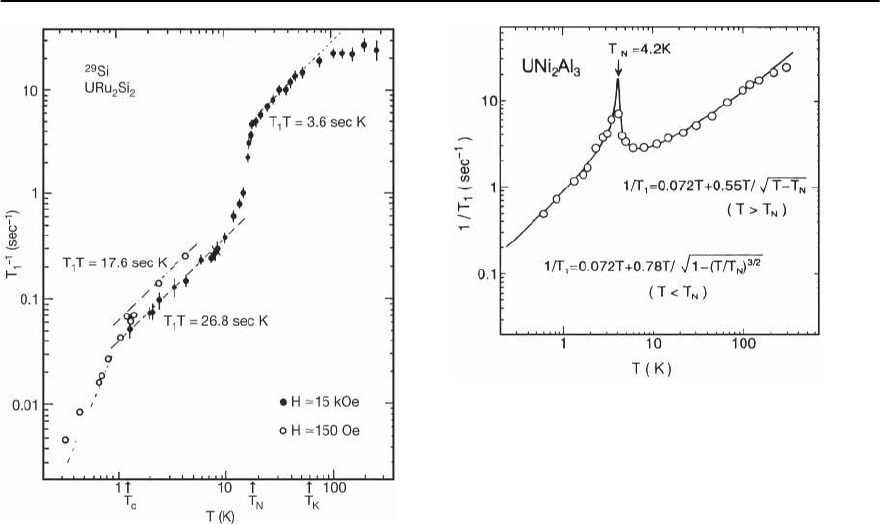
1092 P.S. Riseborough,G.M. Schmiedeshoff,and J.L.Smith
Fig. 19.43. The temperature dependence of the spin-lattice
relaxation rate 1/T
1
for
29
Si in external field (open circles)
and
105
Ru in zero field (solid circles)inURu
2
Si
2
.There-
laxation rate shows an abrupt change at the hidden order-
ing temperature T
N
and at the superconducting transition
temperature T
c
. [After Kohara et al. [280]]
shown in Fig. 19.43. The data does not show any sign
of a spin-wave contributionto the relaxation process.
For non-interacting quasi-particles,thecoefficient of
the T term in the Korringarate isproportional to the
square of the quasi-particle density of states. Thus,
the drop in the coefficient of T found on entering
the N´eel state is indicative of a partial gapping of
the Fermi surface. This is consistent with the drop in
the specific heat from 180 mJ mol
−1
K
−2
above to
50 mJ mol
−1
K
−2
below the transition. Although no
direct evidence of antiferromagnetic ordering was
observed in NMR measurements at ambient pres-
sure, experiments at P =8.3 k bar [224] show a well
defined splitting of the resonance line at T
N
.The
splitting is consistent with the staggered exchange
splitting from a type I antiferromagnetic structure.
In addition, the NMR spectra showed a substantial
contribution from the un-split resonance line that
continued,butdiminished in intensity as the temper-
Fig. 19.44. The temperature dependence of the spin-lattice
relaxation rate 1/T
1
for
27
Al in UNi
2
Al
3
.[AfterKyogakuet
al.[282]]
ature was reduced below the N´eel temperature. Since
the magnitude of the staggered exchange field starts
leveling off below 15 K, and as the ratio of intensities
of the split and un-split lines continuously change
with T, it has been suggested that regions of anti-
ferromagnetism and paramagnetism coexist inside
the single crystal sample but with temperature de-
pendent volume fractions. The interpretation based
on the temperature and pressure dependent volume
fractions of the two phases is consistent with the
spontaneous magnetic moments inferred from neu-
tron diffraction experiments under pressure [225].
However, as the magnitude of the specific heat jump
at T
N
does not scale with the volume fraction, it has
been suggested that another (as yet unknown) type
of ordering also occurs at T
N
.
The temperature dependence of 1/T
1
of UPd
2
Al
3
[282] is very similar to that found in URu
2
Si
2
,inthat
it shows a Korringa rate that shows a partial reduc-
tion of the density of states at the Fermi energy on
entering the magnetically ordered state. The proper-
ties of UNi
2
Al
3
are quite different from UPd
2
Al
3
,in
that the Korringa law does not apply above T
N
=4.2
K, and any linear T coefficient is quite small. As seen
in Fig. 19.44, the magnetic transition is marked by
apeakin1/T
1
, which is indicative of strongly anti-
ferromagnetically coupled local moments. At lower

19 Heavy-Fermion Superconductivity 1093
Fig. 19.45. The temperature dependence of the spin-lattice
relaxation rate 1/T
1
for
63
Cu in CeCu
6
and
29
Si in CeRu
2
Si
2
.
[After Kitaoka et al. [283]]
temperatures, superconductivity occurs before any
linear T region develops. When a sufficiently large
magnetic field is applied to suppress the supercon-
ductivity, a linear T dependence can be resolved.
The longitudinal magnetic relaxation rates have
been measured at the Cu site of CeCu
6
[283] and
at the Cu and Si sites of CeCu
2
Si
2
[276,284,285]. In
CeCu
2
Si
2
, the low temperature relaxation rate varies
linearly with T up to T = 5 K, but has a coefficient
of proportionality of 5 s
−1
K
−1
.Thislargevalueof
the slope should be contrasted with the correspond-
ing slope of 0.025 s
−1
K
−1
found in the compound
LaCu
2
Si
2
,which doesnotcontain anyf electrons.The
enhanced value of the low temperature relaxation
rate is even more apparent in CeCu
6
,where1/T
1
fol-
lows a linear Korringa law below about T =0.2
Kwithaslopeof88s
−1
K
−1
[283]. The relaxation
rates for CeCu
6
and CeRu
2
Si
2
are shown in Fig.19.45.
At higher temperatures, the relaxation rate of CeCu
6
starts changing form and shows a plateau associ-
ated with the cross-over temperature T
K
of 12 K,and
above this, it shows a slow decrease with increasing
temperature due to the Curie-like variation of the
susceptibility. Fromthe temperature variation of the
longitudinal relaxation rate, one finds that the low
temperature Fermi liquid in CeCu
6
only starts form-
ing at a temperature lower than the cross-over tem-
perature by a factor of 60,whereasfor UBe
13
this ratio
is estimated to be about 9. It is noteworthy that the
result for CeCu
6
does not show the scaling expected
from the single-impurity Anderson model, despite
the fact that the non-local contributions to the mag-
netic response found from neutron scattering are es-
timated as being only 10%. However, the ratio found
for UBe
13
is more in line with the expectation based
on the single-impurity Anderson model [286] de-
spite the presence of strong antiferromagnetic cor-
relations as indicated by the Korringa ratio.
The transverse magnetic relaxation rate 1/T
2
pro-
vides information about processes whereby the nu-
clear spin precession is dephased and does not in-
volve transitions where there is a change of Zeeman
energy. On neglecting the effects of static random
local fields, the transverse relaxation rate is given by
perturbation theory as
T
2
2
=
3
4
I(I +1)|A
hf
|
4
(19.168)
×
1
N
q
2
(q)−
1
N
q
(q)
2
,
which measures the non-uniform component or q
variation of the static susceptibility.For systems close
to a magnetic instability in which (q
) peaks up
around a ordering vector Q
, one expects that the sus-
ceptibility mayhaveanOrnstein–Zernickeformwith
a correlation length ,
(q
)=
(Q
)
1+|q − Q|
2
2
. (19.169)
Thus, one finds that
T
2
2
∝
−3
2
(Q) (19.170)
andas,fromthesimplescalinghypothesis(Q
) ∝
2
,onehas
1
T
2
∝
1
2
. (19.171)
Thus,one expects 1/T
2
to be enhanced in the vicinity
of a magnetic phase transition. Furthermore, in the
ordered state, the precession frequency is expected
to be changed due to the presence of static mag-
netic moments or local fields. This information can
be used to provide information about the size of the
ordered moments.
In addition to 1/T
2
relaxation rates, NMR
linewidths are also sensitive to local static magnetic
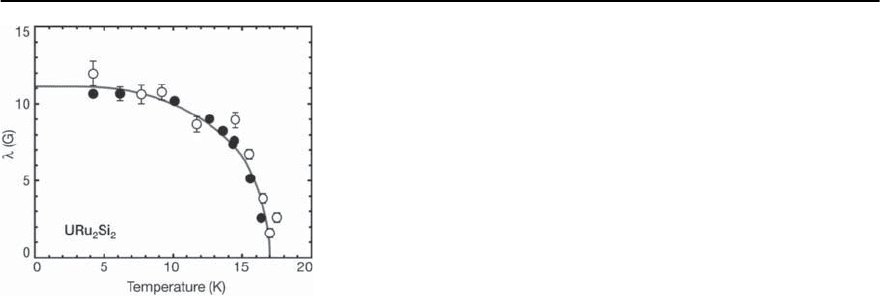
1094 P.S. Riseborough,G.M. Schmiedeshoff,and J.L.Smith
Fig. 19.46. The temperature dependence of the anomalous
component of the
29
Si line width (T)inURu
2
Si
2
.Open cir-
cles H to c,solid circles H ⊥to c.[After Bernal et al.[287]]
fields [287]. This has provided some additional in-
formation on the T =17.5 K transition in URu
2
Si
2
.
In this compound it was found that,for temperatures
above T
N
, the linewidth is linearly-dependent on the
field and has an anisotropy similar to that of the
sample’s magnetization.However,belowT
N
,themea-
surements also show an additional isotropic, field-
independent, contribution to the linewidth which is
shown in Fig. 19.46. The temperature dependence
of the isotropic component is similar to that ex-
pected from a mean-field transition that occurs at
T
N
. Since at ambient pressures the signal is predom-
inantly from the paramagnetic regions of the sam-
ple, and as (unlike the magnetic ordering) the field-
independent contribution to the width is isotropic,
the authors suggest that the width is due to the cou-
pling to the unknown or “hidden" order parameter.
Muonspin relaxationworks in muchthe same way
as NMR, but the zero field precession rate is much
more sensitive to ordered magnetic moments with
small magnitudes. Also as the muon precession fre-
quency is extremely slow,SR is effective in discrim-
inating between slowly varying magnetic order and
static order. Therefore, muon spin relaxation mea-
surements have played a particularly important role
in identifying magnetic phase transitions, specially
as the transition to magnetically ordered phases of
heavy-fermions may or may not be accompanied by
specific heat anomalies. In the case of UPt
3
,Cooke
et al. [288] discovered the existence of magnetic or-
dering at T
N
= 5 K through the zero field muon
spin relaxation line width 1/T
2
,eventhoughnocor-
responding specific heat anomaly was observed at
the transition. The transverse relaxation rate showed
the growth of an additional contribution below T
N
corresponding to an increase in the local fields due
to a very small moment of order 0.01
B
.Thesmall
magnitude of the ordered moment is presumably re-
sponsible for the absence of a specific heat anomaly
at T
N
.The existenceof magnetic ordering was rapidly
confirmed by neutron scattering experiments [289].
However, later muon resonance experiments on bet-
ter quality samples no longer showed this feature in
the muon relaxation rate [290]. This discrepancy is
presumably caused by the exact cancelation of the
field due to the ordered moment at the muon sites
which is disrupted by the presence of disorder and
thereby revealing a finite staggered magnetization.
In URu
2
Si
2
, the magnetic transition is accompa-
nied by a large change in the specific heat at T
N
=
17.5 K, but the size of the average ordered magnetic
moments found from neutron and x-ray scattering
areonlyoftheorderof0.03
B
. Although transverse
relaxation rates and Knight shift measurements do
indicate that magnetic ordering occurs,the static or-
dered magnetic moments inferred from the muon
measurements [291,292] are an order of magnitude
smaller than the average magnetic moments found
from the neutron scattering experiments at ambient
pressure. Due to the large magnitude of the specific
heat jump and the small magnitude of the averaged
ordered moments, it has been suggested [293–295]
that the primary ordering is non-magnetic. How-
ever, polarized diffraction experiments and a sym-
metry analysis seem to rule out higher order mul-
tipolar transitions [296]. Also, measurements in ap-
plied fields do not yield evidence for exotic types of
multiple spin correlations [297].
In CeAl
3
,bycontrastwithURu
2
Si
2
where a large
specific heatanomaly is found at T
N
,onlyaslightand
sample dependent specific heat anomaly has been
observed. However, the muon spin resonance spec-
trum shows evidence that magnetic order develops
in CeAl
3
at T =1.5 K [298,299]. Furthermore, near
T =0.7 K where the susceptibility shows a maxi-
mum, the ordered moment is quite sizeable and has
been reported to be as large as 0.5
B
[300]. The lack

19 Heavy-Fermion Superconductivity 1095
of correlation between the size of the ordered mo-
ments and the size of the specific heat jump is not
understood. However, the magnetic ordering does
appear to show up in the resistivity of single crys-
tals where a T
3
variation has been observed [301].
The T
3
variation is indicative of the existence of a
low-energy branch of spin-wave excitations.
Evidence for static magnetic order in CeCu
2
Si
2
in
zero field and longitudinal field muon spin relaxation
has beenreported[302]justabovethesuperconduct-
ing transition temperature T
c
=0.7K.Theinferred
size of the ordered magnetic moments is of the order
of 0.1
B
. However, the intensity of the NQR line de-
creases monotonically with decreasing temperature
andshows no anomalous broadening associatedwith
ordered magnetic moments [303,304].Themagnetic
ordering persists in the superconducting phase and
competes with the superconductivity [305–307]. In-
vestigations show evidence that the superconductiv-
ity and magnetic orderingmay exist in separate ther-
modynamic phases,but these are phases for which T
c
and T
N
coincidein the best qualitysamples.Applica-
tion of a magnetic field suppresses the superconduc-
tivity transition temperature but (initially) has no
effect on T
N
. The zero field muon spin relaxation ex-
periments show two components that decay at rates
that differ by about an order of magnitude [307].
The data can be interpreted in terms of the sample
existing in two separate phases: the superconduct-
ing phase and a magnetic A phase. An estimate of
the weight of these two phases can be made based
on the amplitudes of the two components. For tem-
peratures above the superconducting transition, the
proportion of the A phase increases with decreas-
ing T, reaching a maximum at T
c
with a value of
3
4
.
The magnitude of the specific heat jump at the su-
perconducting transition seems to scale with the rel-
ative weights of the two phases. As the temperature
is lowered, the volume fraction associated with the
superconductor grows by expelling the A phase and
saturates at about a volume fraction of
2
3
.Therela-
tive weights of the superconducting phase and the A
phase are extremely sensitive to the deviations from
stoichiometry of Ce [191]. Doping experiments have
shown that substitutionally doping Th on theCe sites
can lead to the formation of an antiferromagnetic
state with a significantly larger magnetic ordering
temperature for Th concentrations of only about 7%.
Neutron Scattering Cross-Section
The most direct way of obtaininginformation about
the magnetic excitations in a material is through in-
elastic neutron scattering experiments in which mo-
mentum q
and energy ! are transferred between
the neutron and the sample. The neutron interacts
with the electronic spins via a dipolar interaction
and yields information about the imaginary part of
the dynamic susceptibility. The differential scatter-
ing cross-section for an unpolarized beam of neu-
trons due to purely magnetic scattering, is given by
d
2
d!d§
= N
g
n
e
2
g
B
m
e
c
2
2
k
k
1+N(!)
(19.172)
×
F(q)
2
˛,ˇ
Im
˛,ˇ
(q; !)
ı
˛,ˇ
− ˆq
˛
ˆq
ˇ
.
Here, F(q) is the atomicform factor for the magnetic
moments, k and k
arethemagnitudeoftheinci-
dent and scattered neutron wave vectors, and N(!)
istheBose–Einstein distributionfunction.The above
expression should also be multiplied by the Debye–
Waller factor due to zero point and thermally excited
lattice vibrations.
Generally, the low-energy dynamic magnetic re-
sponse of a heavy-fermion system is interpreted as
the sum of a large quasi-elastic relaxation contribu-
tion that is q
independent and q dependent terms
associated with spatial magnetic correlations. The
relaxational component is of the form
Im
(q; !)
= A
!
2
!
2
+
2
, (19.173)
whichis indicative of local moment fluctuations.The
width of the quasi-elastic peak seems to saturate at
low temperatures but increases with increasing T at
higher temperatures. The q
independence and the
temperature variation of the width found in some
Ce systems [229,230,308]are similar to the behaviors
found in the single-impurity Anderson model [309],
where
(T) ∼ (0) + B
√
T . (19.174)

1096 P.S. Riseborough,G.M. Schmiedeshoff,and J.L.Smith
Fig. 19.47. The temperature dependence of the experimen-
tally determined half-width of the quasi-elastic peak in
CePb
3
. [After Balakrishnan et al. [312]]
The temperature dependence of the quasi-elastic
linewidth of CePb
3
is shown in Fig. 19.47. The prod-
uct of the zero temperature limit of the linewidth
and the linear T term in specific heat, (0) ,should
scale inversely with the Wilson ratio. For CeAl
3
[308], CeCu
6
and CeRu
2
Si
2
[310, 311] respectively,
the product has magnitudes of 0.77, 0.67 and 0.70
J meV/mole/K
2
, even though the widths show con-
siderable variation with q
.Bycontrast,inCePb
3
where no q dependence was observed [312], the
product is only 0.034, whereas the Wilson ratio ob-
tained from thermodynamic measurements at the
same temperatures is of the order of unity [183].
Similar narrow quasi-elastic peaks are found in U
heavy-fermion systems [313] and can have a wide
range of values for the product (0) .Thenar-
row quasi-elastic response can also be interpreted
as the response of a gas of heavy quasi-particles
in a very narrow band. The q
dependent contribu-
tions may signify fluctuations associated with long-
ranged order or competing types of short-ranged or-
der. In particular, the quasi-particle contribution to
the susceptibility should show up at very low tem-
peratures as a narrow quasi-elastic peak at small en-
ergy and momentum transfers. The intensity of the
peak should be proportional to the quasi-particle
weight but may be significantly reduced by spin-
orbit scattering. For the cerium heavy-fermion com-
pounds [228, 229, 231, 232, 234], the higher energy
spectra also show inelastic peaks due to crystal field
Fig. 19.48. The neutron inelastic scattering cross-section
calculated in the NCA, for the single impurity Anderson
model with parameters appropriate for CePb
3
.Thespec-
trum consists of a low energy quasi-elastic peak and an
inelastic peak due to crystal field excitations in a cubic
environment
Fig. 19.49. The 9 meV quasi-elastic peak observed in po-
larized beam inelastic neutron scattering experiments on
UPt
3
. [After Aeppli et al.[314]]
excitations.As seen in Fig. 19.48,the localized crystal
field excitations can be reasonably described by the
single impurity Anderson model.
Inelastic neutron scattering experiments on UPt
3
show the existence of a local relaxational component
to the response which has a width of = 9 meV [314].
The experimental data are shown in Fig.19.49. The q
dependence is associated with three different types
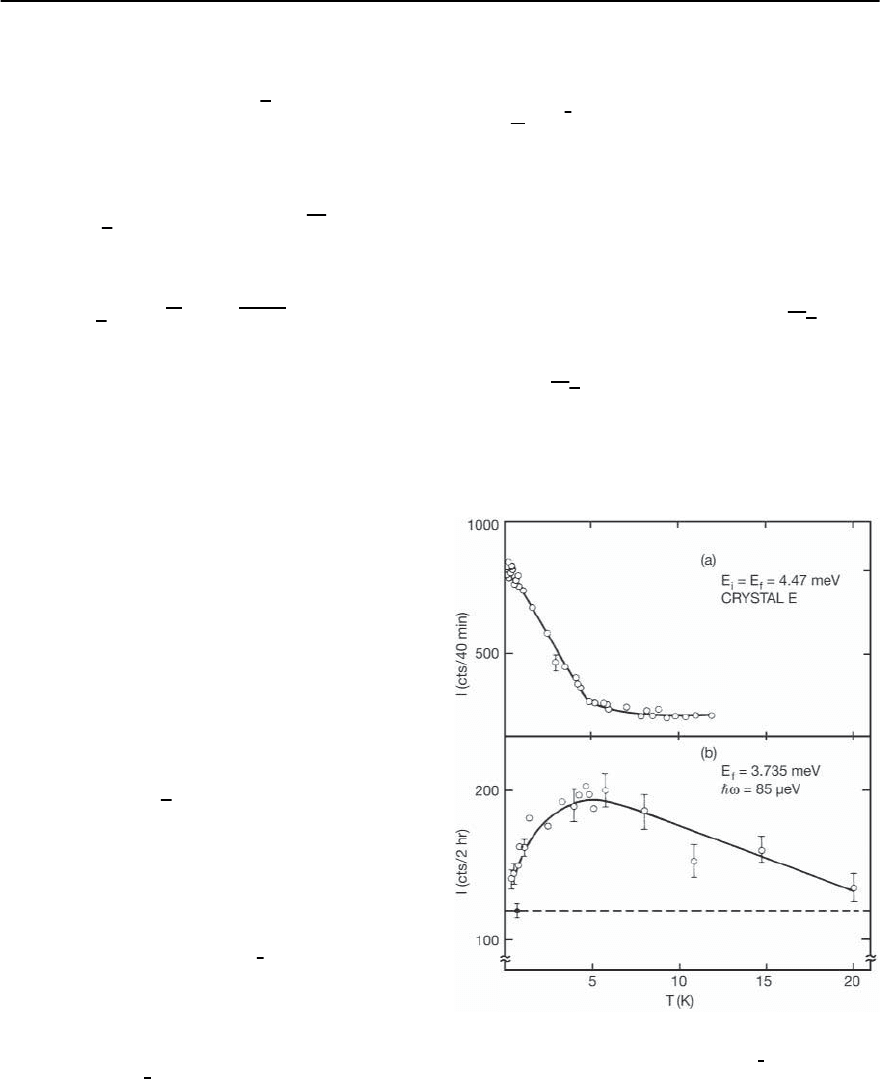
19 Heavy-Fermion Superconductivity 1097
of magnetic correlations.Longwavelengthferromag-
netic (0,0,0) fluctuations gradually start developing
below 150 K [315] and show a q
dependent energy
width (q) ∝ q. These fluctuations are similar to
paramagnons since, for q → 0 fluctuations, one ex-
pects
1−URe
0
(q; !) ∼ 1−U()+O
q
k
F
2
(19.175)
and
Im
0
(q; !) ∼
4
()
!k
F
q
. (19.176)
Within RPA, this behavior of the quasi-particle sus-
ceptibility produces the pre-critical fluctuations ap-
propriate to a damped,but conserved,order parame-
ter. The paramagnon fluctuations could be responsi-
ble for the T
3
ln T term observed in the specific heat
and the value of the large Korringa ratio [277,278].
In addition to the (0,0,0) fluctuations, there are two
types of antiferromagnetic modes in the spectrum.
A quasi-elastic peak starts developing below T =30
K centered at momentum transfers of (0, 0, 1) and
is characterized by a large energy width ∼ 5meV
[316,317]. This signifies the presence of a rapidly
changing short-ranged magnetic order in which the
two uranium ions in the unit cell are antiferromag-
netically coupled. This produces an antiferromag-
netic correlation between the spins along the c-axis
and a ferromagnetic correlation between the spins
in the basal plane. The intensity of the inelastic
peak decreases as q
is varied away from (0, 0, 1).
The width of the peak q ∼
−1
provides a mea-
sure of the correlation length . The anisotropy of
the correlation length in UPt
3
suggests that fluctuat-
ing in-plane ferromagnetic correlations are present
for temperatures as large as T = 100 K. The sec-
ond type of antiferromagnetic fluctuations is asso-
ciated with a wave-vector of (
1
2
, 0, 1) which devel-
ops at T = 18 K and peaks at a frequency of the
order of 0.2 meV. Magnetic ordering occurs at this
wave-vector below the critical temperature of T
N
=5
K, as evidenced by the development of magnetic
Bragg peaks at (
1
2
, 0, 1), since the magnetic Bragg
peak intensities are (apart from the temperature de-
pendent Debye–Waller factor) proportional to the
square of the sub-lattice magnetization. The mag-
netic momentsare in thebasal plane of thehexagonal
structure and are aligned parallel to the propagation
vector Q
≡ (
1
2
, 0, 0). The magnitude of the ordered
moments found through neutron diffraction experi-
ments are anomalously small.The measured ordered
moment only attain the value of 0.02
B
per U ion just
above the superconducting transition temperature
T
c
[289]. The temperature dependence of the inten-
sity of the magnetic Bragg peak of UPt
3
is shown in
Fig. 19.50. The temperature dependence of the mag-
nitude of the sub-lattice magnetization M
Q
(T)fol-
lows the scaling law
|M
Q
(T)|∝(T
N
− T)
ˇ
(19.177)
for T
N
> T,whereˇ ∼ 0.5.Thevalueofthecrit-
ical exponent is not consistent with the values ex-
pected for three-dimensional ordering of localized
magnetic moments.Similar values of ˇ are also found
Fig. 19.50. (a) The temperature dependence of the elas-
tic scattering intensity for UPt
3
at q =(
1
2
, 0, 1). For pur-
poses of comparison, (b) shows the temperature depen-
dence of scattering with energy transfers of 85 eV at
q =(0.52, 0, 0.99). [After Aeppli et al. [318]]
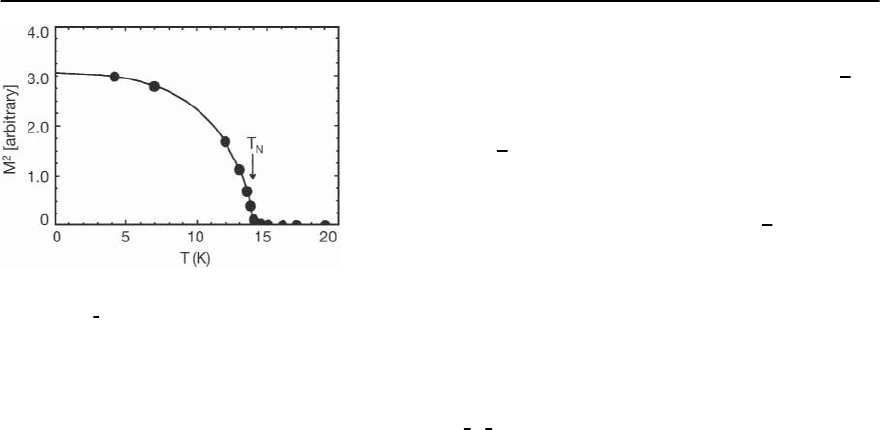
1098 P.S. Riseborough,G.M. Schmiedeshoff,and J.L.Smith
Fig. 19.51. The temperature dependence of the intensity
of the (0, 0,
1
2
) antiferromagnetic Bragg peak in UPd
2
Al
3
.
[After Petersen et al. [343]]
in other systems with anomalously low magnetiza-
tions such as URu
2
Si
2
at ambient pressure. The crit-
ical exponents ˇ found for other magnetically or-
dered heavy-fermion systems with larger moments
such as UNi
2
Al
3
,UPd
2
Al
3
and U
2
Zn
17
,haveval-
ues close to 0.35 which are within the range ex-
pected for three-dimensional ordering of localized
moments. For comparison, we show the temperature
dependence of the magnetic Bragg peak intensity of
UPd
2
Al
3
in Fig.19.51.The correlationlengths associ-
atedwith the Bragg peaks of UPt
3
remain finite above
andbelowT
N
,andareof theorder of 250–500 Å [318].
As the cross-section for elastic Bragg scattering is
proportional to the energy conserving Dirac delta
function ı(!), measurements of the elastic Bragg
peaks involve windows of energy transfers which in-
cludes the point ! = 0.Thus,the Bragg intensity also
contains contributionsfrom low-energy critical scat-
tering, which have finite correlation lengths. Since
the Bragg peaks were observed to have finite correla-
tion lengths, questions are raised as to the nature of
the ordering whether it is quasi-static short-ranged
ordering, or whether it is long-ranged ordering that
is interrupted by the presence of defects [319].Muon
spin resonance experiments confirmed the presence
of magnetic ordering at T
N
∼ 5 K [288,320].As the
temperature is reduced from just above the super-
conducting transition temperature, the intensity of
the antiferromagnetic Bragg peaks shows a sudden
change of slope as it starts to decrease. This indi-
cates that the antiferromagnetic ordering coexists
and competes with the superconductivity [321].
Inelastic neutron scattering experimentson UBe
13
[322,323] at T ∼ 10 K show an approximately q in-
dependent relaxational paramagnetic response with
a large quasi-elastic width = 14 meV. The approxi-
mateq
independence of the inelastic scattering cross-
section is indicative of the localized nature of the
magnetic fluctuations.At energy transfers less than
2 meV [313],there is another roughly q
independent
quasi-elastic component to the spectrum, of width
∼ 1.6meVatT =1.0 K, which decreases to 1.0
meV at T =0.6 K. If these smaller values of (0)
are combined with the specific heat coefficient ,the
product (0) has a value of 1.7 which is closer to
the values found for Ce heavy-fermion compounds.
Antiferromagnetic like correlations are apparent in
the quasi-elastic spectrum at momentum transfers
(
1
2
,
1
2
, 0) below a temperature of 30 K [324], but no
long-ranged magnetic order was found.
Neutron scattering experiments on URu
2
Si
2
show
an instability to an antiferromagnetically ordered
state below T
N
=17.5 K with average ordered mag-
netic moments of only ∼ 0.03
B
[325] or 0.023
B
per U [326]. The value of the ordered moment in-
creases when pressure is applied, becoming as large
as 0.25
B
per U atom at P =1.3 GPa [225]. The mea-
sured value of the critical exponent for magnetic or-
der parameter is ˇ ∼ 0.5 at ambient pressure. How-
ever, for URu
2
Si
2
, the comparison of NMR and neu-
tron diffraction experiments under pressure [224]
indicate that magnetism only occurs in a small tem-
perature dependent fraction of the sample volume
and that, if the temperature dependence of the vol-
ume is accounted for, the critical exponent ˇ falls
within the normal range. Initial reports suggested
that the correlation length remained finite and was
of the order 200 to 400 Å. Later, it was found that the
correlation length is sample dependent and that the
Bragg peaks of the highest quality samples were reso-
lutionlimited [327].The orderingfoundis consistent
with a Type I antiferromagnetic structure in which
the spins align parallel in planes perpendicular to
the tetragonal c-axis and are anti-parallel between
planes. Since “hidden ordering” has been suggested
as the cause of the large specific heat jump at T
N
,
neutron diffraction measurements were performed
using polarized beams and applied fields. However,
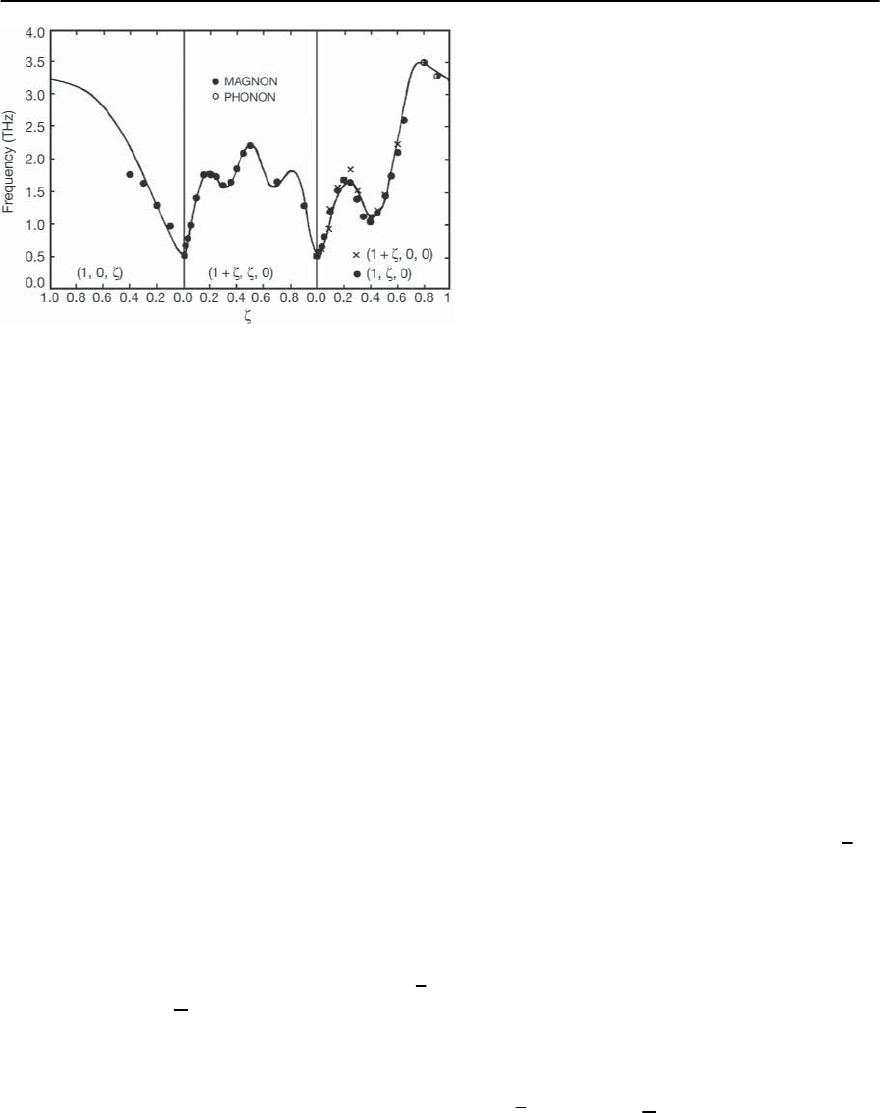
19 Heavy-Fermion Superconductivity 1099
Fig. 19.52. The dispersion relation of a sharp magnetic
excitation observed in URu
2
Si
2
.The dispersion relation
is shown in the (1, 0, ),(1 + , , 0) and (1, 0, ) direc-
tions. It should be noted that the dispersion relation
does not go soft, as is expected for isotropic antifer-
romagnetic spin waves, but instead shows a gap. The
existence of a gap is indicative of magnetic anisotropy.
[After Broholm et al.[329]]
these experiments show no evidence of the “hidden
ordering” [296,297].
At temperatures of the order of T =50K,thein-
elastic scattering spectrum of URu
2
Si
2
[328] shows
the presence of a broad quasi-elastic response of
width ∼ 6 meV, suggesting that the spins have
relaxational dynamics. Below the N´eel temperature,
the inelastic scattering spectra show that both sharp
spin-wave-like excitations and broad relaxational
spin-fluctuations coexist in the antiferromagnetic
state. At T = 1 K, there are well defined dispersive
spin-wave peaks along the (1, q, 0) direction that
have a minimum excitation energy of 1.8 meV at
the Antiferromagnetic zone boundary [329] which is
located at q = 0. The dispersion relation for these
magnetic excitations is shown in Fig.19.52.The lon-
gitudinal character of the spin-wave excitations, the
Ising-like nature of the magnetic ordering, and the
existence of a gap, all indicate that there is con-
siderable anisotropy in the magnetic interactions
at low temperatures. The spin-wave excitations are
rapidly damped out above the N´eel temperature T
N
.
The spectrum of magnetic fluctuations in the en-
ergy range between 4 and 12 meV appears to have
a short correlation length, of the order of the lattice
spacing, in that the intensity decreases slowly as q
is varied away from Q =(1, 0, 0). The response in
this energy range seems to be associated with Stoner
excitations of the gas of heavy quasi-particles. Since
URu
2
Si
2
has a large magnetic anisotropy, and as it
mayplayanimportantroleintheformationof super-
conductivity,inelastic scattering measurements were
made with the view of identifying the source of the
anisotropy [330].Although crystal-field-likefeatures
were observed at the high energies of 49, 99 and 158
meV, these features had widths of 64, 36 and 89 meV,
which are comparable with the splittings. This in-
dicates that the f states in URu
2
Si
2
are much more
strongly hybridized with the conduction band states
than in the Ce heavy-fermion compounds, and per-
haps, have a large mixed valent character. Like UPt
3
,
the intensity of the antiferromagnetic Bragg peak in
URu
2
Si
2
is diminished at the onset of the supercon-
ducting transition [331].
The inelastic neutron scattering spectra of cerium
based heavy-fermion compounds are different from
the uranium based heavy-fermion compounds in
that they show clear evidence of crystal field split-
tings. An example is given by the inelastic neutron
scattering spectra of CeAl
3
[234], which is shown in
Fig. 19.53. Like the uranium compounds, the cerium
compounds also show the existenceof an almost q
in-
dependent quasi-elastic peak which develops at low
temperatures, but in the low temperature limit, the
widths attain smaller values. For example, the width
found in CeCu
2
Si
2
[229,332] is of the order of 1 meV,
and is less than 0.5 meV for CeAl
3
[308].
In CeCu
6
, the magnetic fluctuations exhibit an
Ising-like anisotropy along the b-axis. Two differ-
ent components of quasi-elastic magnetic scattering
were identified [333,334].Thefirstcomponent which
becomes apparent at temperatures below 10 K,has an
almost q
independent quasi-elastic response with a
width that follows a
√
T temperature variation and
